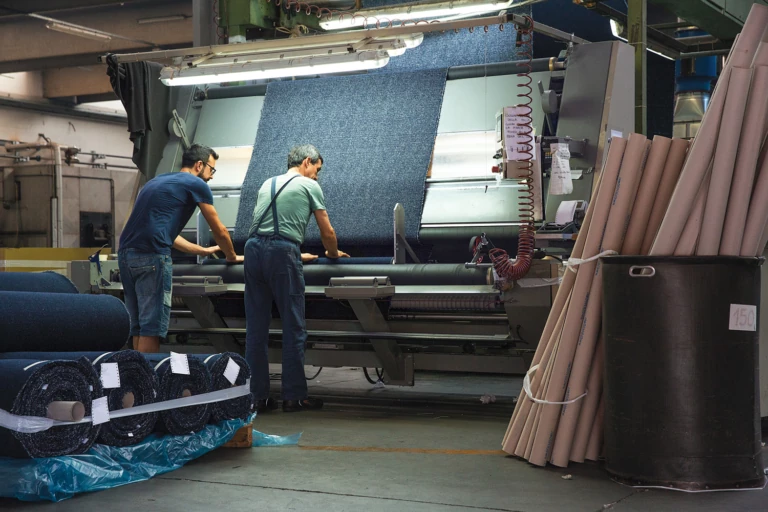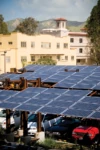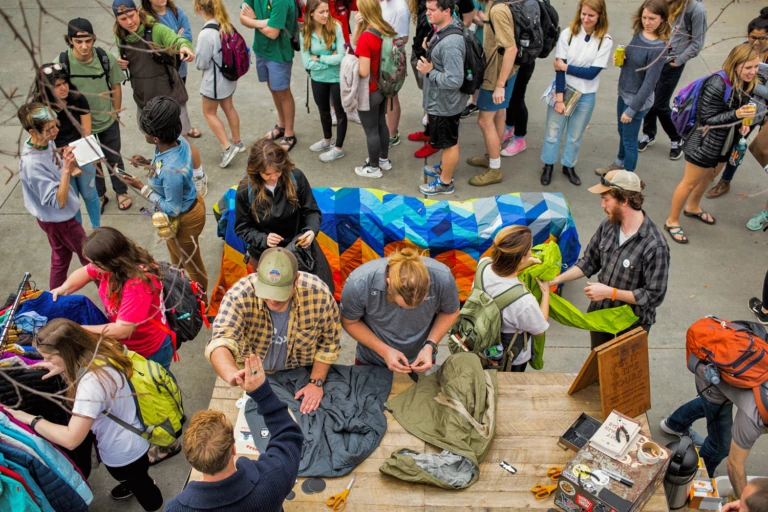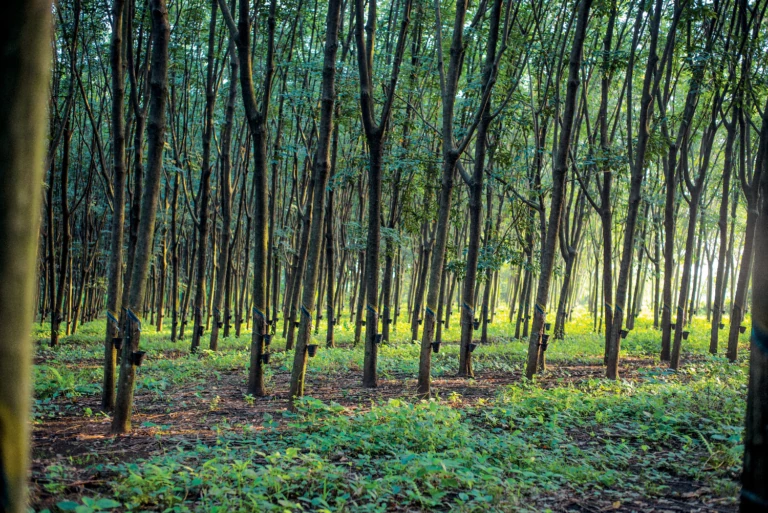How We’re Reducing Our Carbon Footprint
Ever since Patagonia had an office (and wasn’t just selling gear out of the back of Yvon’s car), we’ve devoted desk space, our free time and a percentage of our sales to protecting wild nature. From our travels, we knew our land, air and water was in real trouble from short-sighted profiteers.
Over the years, it also became clear that in speaking up for the trees, rivers, salmon and grizzlies, we were not only fighting for the places (and critters) we love but also for everyone. No place is safe from the overheating atmosphere, and soon the lives we save may be our own. The climate crisis is a human issue.
The science is clear in stating that the primary cause of the climate crisis is an excess of carbon dioxide and other gases that trap heat in the atmosphere, and, honestly, our business is deeply implicated. From petroleum-based polyester threads and fabrics woven on coal-powered machines to waterproofing treatments and shipping clothes in plastic mailbags, we’re enmeshed in carbon emissions. Many of us still drive to work in cars and travel by airplane. It’s a lot to change, but we’re working our tails off to do so. We’ve set an ambitious, but attainable goal to reach carbon neutrality by 2025 across our entire business, including our supply chain.

De acuerdo, tal vez no sea totalmente verde, pero es mucho menos “café”. Esta fábrica en Italia, dirigida por la familia Calamai, produce la lana reciclada que usamos en nuestra ropa de lana reciclada y Woolyester. Reciclar tejido no elimina toda la contaminación de gases de efecto invernadero asociada, pero sí reduce las emisiones de carbono, dependiendo de la fibra, en un rango del 44 al 80%. Foto: Jeff Johnson
The supply chain is what textile and other manufacturers use to describe everything from the crops grown to make yarn to the sewing of fabric into garments and the shipping of finished clothes to warehouses, stores and, ultimately, your mailbox. Patagonia’s supply chain accounts for 97% of our carbon emissions.
When we say we’ll be “carbon neutral” (“net zero” is another term you’ll hear), that means that we will eliminate, capture or otherwise mitigate all of the carbon emissions we create, including those from the factories that make our textiles and finished clothing, and the farms that grow our natural fibers. That last part is crucial. There’s a common misperception that much, or most, of our carbon pollution comes from transportation. In fact, 86% of our emissions (all but 11% of the 97%) come from the raw materials we use and their supply chains, which is why we’re so focused on recycling (and more on that in a sec). Our real aim is to become “carbon positive”—meaning we take more carbon out of the atmosphere than we put in, even as our company grows.
It’s a great goal to have, but we haven’t made a lot of noise about it because, well, some of it’s going to be really hard to achieve, and we prefer to talk about stuff we’ve actually done.

Sombra de bienvenida y energía para nuestras computadores: los paneles solares en nuestra sede de Ventura son una de las formaa en que hemos podido abastecer el 100% de nuestras necesidades de electricidad en los EE. UU. a partir de fuentes renovables. Foto: Tim Davis
So, let’s look closer at what we’re doing to get there.
- We will use only renewable electricity for our Patagonia retail stores, distribution centers, regional and global offices and headquarters by 2020. As of now, we are at 100% renewable electricity in the US and 76% globally.
- We will reduce energy use throughout our supply chain, work with suppliers to convert to renewable energy and invest in renewable energy projects to cover the remainder of our carbon footprint. Sometimes, this is as easy as asking a partner to convert. Other times, it’s super-complicated and involves local infrastructure, multiple players and politics.
- We will use only renewable or recycled materials in our products by 2025. Remember how we said most of our emissions come from virgin materials? This one is big. While using recycled fibers doesn’t eliminate carbon emissions, they do reduce them by 44 to 80% (depending on fiber type). If you factor in everything else that goes into making a garment, the impact reduction is less impressive (10-20% per item), but that’s where we see real potential. Meanwhile, converting to renewable and recycled materials reduces water use and keeps plastic from landfills and the oceans. As of fall 2019, 69% of our line includes recycled material.

Por el precio de un high five ayudamos a nuestros clientes, como estos Bulldogs de la Universidad de Georgia, a mantener en juego su polar favorito. Y mantener la ropa fuera de los vertederos ayuda más de lo que piensas. Continuar usando una parka, por ejemplo, durante nueve meses adicionales reduce su huella de carbono en un tercio. Foto: Kern Ducote
- We will grow our Worn Wear® program and make it a robust business unit that supports various initiatives encouraging reuse, repair and recycling to extend the life of products and reduce their environmental footprint. Even nine months of use reduces the carbon footprint of a garment by 30%.
- We’re investing in regenerative organic agriculture as a source of raw materials for our apparel and food for Patagonia Provisions. Regenerative is a catch term for a group of farming practices—organic, compost, little or no till, crop rotation, cover crops and intercrops—that have been shown to have lots of benefits, but first and foremost, promote the creation of healthy topsoil. These techniques have also shown promise for drawing more carbon into the soil and storing it better than other farming methods. So we’re testing it out and working with others to develop a Regenerative Organic Certification to help alert people to products that have the potential to not only do less harm, but more good.
- We will invest in other carbon-capture projects, like reforestation, across the globe.
As a company, there is much more that Patagonia is doing about the climate crisis, including supporting youth climate activists during Climate Week 2019.
In 2018, we changed our mission statement: “We’re in business to save our home planet.” And we’re living this mission in our marketing and communications, and with our documentary films and investments in businesses through Tin Shed Ventures. For example, we’ve invested in Wild Idea Buffalo Company, a ranch in South Dakota whose buffalo are helping restore the Great Plains ecosystem and keep more carbon in the ground. Happily, Wild Idea now supplies the delicious buffalo jerky sold by Patagonia Provisions: a win-win-win.

Nuestra fábrica de trajes de surf. En el caucho natural Yulex®, cosechado de estos árboles de hevea brasiliensis en Guatemala, encontramos un reemplazo al neopreno en base a plantas para nuestros trajes de surf. Un feliz accidente producto de destetarnos del petróleo y los productos petroquímicos ha sido descubrir formas de hacer que nuestros productos no solo sean menos tóxicos, sino simplemente más hermosos. Foto: Tim Davis
Since we gave a desk and a check to a grad student working to restore the Ventura River in 1973, we’ve donated more than $105 million to grassroots environmental organizations. Many of them are concentrating their efforts on climate and building resilience. (You can find a group near you to support or volunteer with on Patagonia Action Works, our social network for activists).
The climate crisis is huge, complicated and often overwhelming, so it’s important to see progress—and we do. We’re seeing carbon reductions in our supply chain, and we’re seeing great wins from the activists we support.
When Mark Capelli took that desk in our offices, the Ventura River was so depleted, a few told him his efforts would be futile. Today, it’s not perfect, but it runs yet, and more cleanly, to the Pacific.

